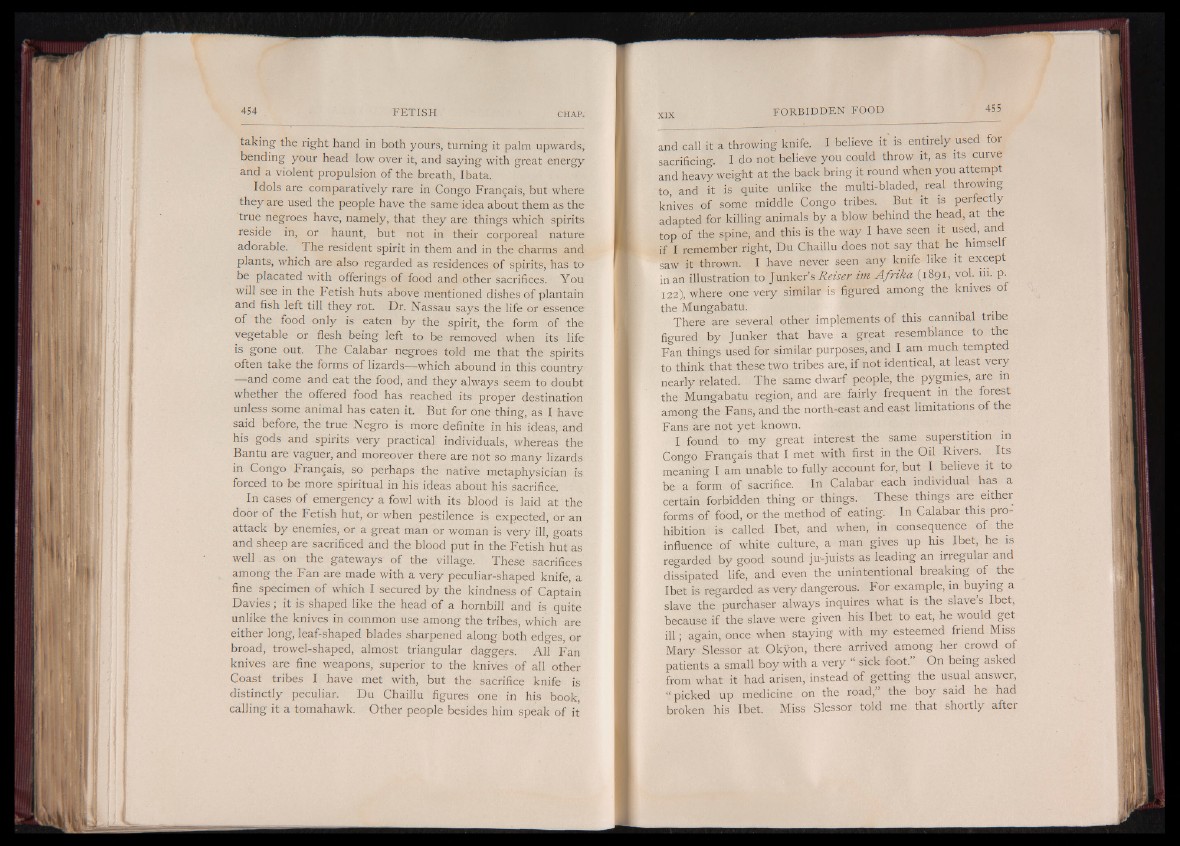
taking the right hand in both yours, turning it palm upwards,
bending your head low over it, and saying with great energy
and a violent propulsion of the breath, Ibata.
Idols are comparatively rare in Congo Français, but where
they are used the people have the same idea about them as the
true negroes have, namely, that they are things which spirits
reside in, or haunt, but not in their corporeal nature
adorable. The resident spirit in them and in the charms and
plants, which are also regarded as residences of spirits, has to
be placated with offerings of food and other sacrifices. You
will see in the Fetish huts above mentioned dishes of plantain
and fish left till they rot. Dr. Nassau says the life or essence
of the food only is eaten by the spirit, the form of the
vegetable or flesh being left to be removed when its life
is gone out. The Calabar negroes told me that the spirits
often take the forms of lizards— which abound in this country
— and come and eat the food, and they always seem to doubt
whether the offered food has reached its proper destination
unless some animal has eaten it. But for one thing, as I have
said before, the true Negro is more definite in his ideas, and
his gods and spirits very practical individuals, whereas the
Bantu are vaguer, and moreover there are not so many lizards
in Congo Français, so perhaps the native metaphysician is
forced to be more spiritual in his ideas about his sacrifice.
In cases of emergency a fowl with its blood is laid at the
door of the Fetish hut, or when pestilence is expected, or an
attack by enemies, or a great man or woman is very ill, goats
and sheep are sacrificed and the blood put in the Fetish hut as
w e ll. as on the gateways of the village. These sacrifices
among the Fan are made with a very peculiar-shaped knife, a
fine specimen of which I secured by the kindness of Captain
Davies ; it is shaped like the head of a hornbill and is quite
unlike the knives in common use among the tribes, which are
either long, leaf-shaped blades sharpened along both edges, or
broad, trowel-shaped, almost triangular daggers. All Fan
knives are fine weapons, superior to the knives of all other
Coast tribes I have met with, but the sacrifice knife is
distinctly peculiar. Du Chaillu figures one in his book,
calling it a tomahawk. Other people besides him speak of it
and call it a throwing knife. I believe it is entirely used for
sacrificing. I do not believe you could throw it, as its curve
and heavyweight at the back bring it round when you attempt
to and it is quite unlike the multi-bladed, real throwing
knives of some middle Congo tribes. But it is perfectly
adapted for killing animals by a blow behind the head, at the
top of the spine, and this is the way I have seen it used, and
if I remember right, Du Chaillu does not say that he himself
saw it thrown. I have never seen any knife like it except
in an illustration to Junker’s Reiser im Afrika (1891, vol. iii. p.
122), where one very similar is figured among the knives of
the Mungabatu.
There are several other implements of this cannibal tribe
figured by Junker that have a great resemblance to the
Fan things used for similar purposes, and I am much tempted
to think that these two tribes are, if not identical, at least very
nearly related. The same dwarf people, the pygmies, are in
the Mungabatu region, and are fairly frequent in the forest
among the Fans, and the north-east and east limitations of the
Fans are not yet known.
I found to my great interest the same superstition in
Congo Français that I met with first in the Oil Rivers. Its
meaning I am unable to fully account for, but I believe it to
be a form of sacrifice. In Calabar each individual has a
certain forbidden thing or things. These things are either
forms of food, or the method of eating. In Calabar this prohibition
is called Ibet, and when, in consequence of the
influence of white culture, a man gives up his Ibet, he is
regarded by good sound ju-juists as leading an irregular and
dissipated life, and even the unintentional breaking of the
Ibet is regarded as very dangerous. For example, in buying a
slave the purchaser always inquires what is the slave s Ibet,
because if the slave were given his Ibet to eat, he would get
ill ; again, once when staying with my esteemed friend Miss
Mary Slessor at Okÿon, there arrived among her crowd of
patients a small boy with a very “ sick foot.” On being asked
from what it had arisen, instead of getting the usual answer,
“ picked up medicine on the road,” the boy said he had
broken his Ibet. Miss Slessor told me that shortly after